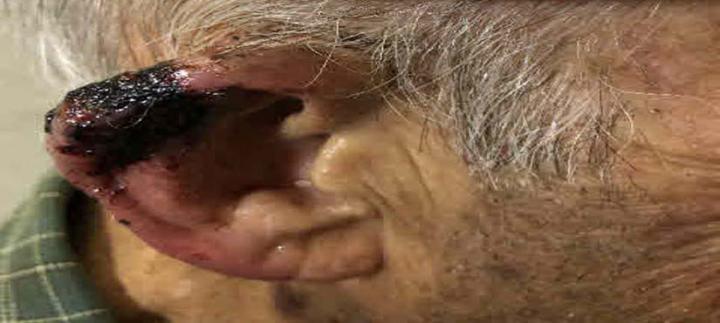
Credit: Study author and RSNA
CHICAGO – The use of high-dose-rate brachytherapy to treat elderly patients with common skin cancers offers excellent cure rates and cosmetic outcomes, according to a new study presented today at the annual meeting of the Radiological Society of North America (RSNA).
Squamous cell carcinoma (SCC) and basal cell carcinoma (BCC) are the most common types of skin cancer, affecting 3 million Americans each year. Although they are highly curable and less dangerous than melanoma, they can be disfiguring and costly to treat. Treatments for squamous and basal cell carcinomas include surgical removal and conventional, or external beam, radiation therapy.
“For elderly patients who don’t heal as well and may have additional medical problems, surgery may not be the best option,” said Ashwatha Narayana, M.D., chairman of the Department of Radiation Oncology at Northern Westchester Hospital in Mount Kisco, N.Y. “If the affected area is the tip of the nose, ear or on the eyelid, multiple surgeries and skin grafting may be required.”
In high-dose-rate brachytherapy, a precise dose of radiation is delivered to the cancerous cells through catheters implanted into a custom-fitted applicator. Unlike six-week external beam radiation therapy, in which treatment sessions can last up to six hours, a course of high-dose-rate brachytherapy includes six three-minute sessions over two weeks.
“Treatment with external beam radiation therapy can be too long and painful for elderly patients,” Dr. Narayana said. “It also exposes healthy tissue around the lesion to radiation, which can increase side effects. Brachytherapy delivers a higher dose of radiation directly to the tumor while sparing healthy tissue nearby.”
According to Dr. Narayana, brachytherapy patients have minimal recovery time and typically experience few or no side effects that can be associated with the treatment, such as nausea, hair loss or diarrhea. They can also return to normal activities after the procedure.
In the study, radiologists used high-dose-rate brachytherapy to treat 70 patients between the age of 70 and 100 (median age 85 years) with early-stage BCC and SCC. A total of 81 lesions (BCC: 53, SCC: 28) on the nose, face, forehead, scalp, ear, neck and legs were treated between 2013 and 2019. Lesions ranged in size from 3 to 26 millimeters (mm) with a median of 10mm. Patients were followed for up to four years (median follow-up: 2 years).
“We had a cure rate of 96% in patients with squamous cell carcinoma and 98% in patients with basal cell carcinoma, and cosmetic outlook was excellent in 90% of cases,” Dr. Narayana said. “This is a great treatment option compared to surgery.”
Despite being a well-recognized treatment that is used routinely to treat other types of cancers, Dr. Narayana said brachytherapy has failed to catch on for the treatment of non-melanoma skin cancers on the face and neck. He hopes results of his study and future research will help raise awareness of high-dose-rate brachytherapy as an alternative to surgery and external beam radiation therapy.
“High-dose-rate brachytherapy is a powerful way of treating skin cancers in both elderly and younger patients,” he said. “The results are impressive.”
###
Co-authors are Carolyn Troy, B.S.N., R.N., Judith Hasak, B.S.N., R.N., Samuel Cotte, A.R.R.T., R.T., and Christopher Fey, M.D.
Note: Copies of RSNA 2019 news releases and electronic images will be available online at RSNA.org/press19 beginning Monday, Nov. 25.
RSNA is an association of over 53,400 radiologists, radiation oncologists, medical physicists and related scientists, promoting excellence in patient care and health care delivery through education, research and technologic innovation. The Society is based in Oak Brook, Ill. (RSNA.org)
Editor’s note: The data in these releases may differ from those in the published abstract and those actually presented at the meeting, as researchers continue to update their data right up until the meeting.
For patient-friendly information on brachytherapy, visit RadiologyInfo.org.
Media Contact
Linda Brooks
[email protected]
630-590-7762



